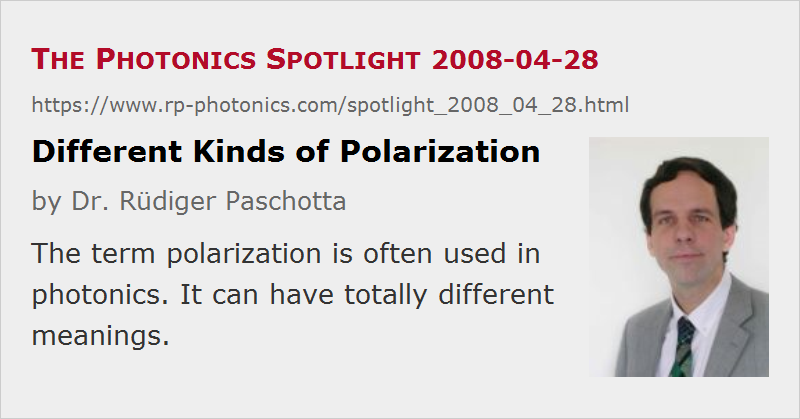Different Kinds of Polarization
Posted on 2008-04-28 as a part of the Photonics Spotlight (available as e-mail newsletter!)
Permanent link: https://www.rp-photonics.com/spotlight_2008_04_28.html
Author: Dr. Rüdiger Paschotta, RP Photonics Consulting GmbH
Abstract: The term polarization is often used in photonics. It can have totally different meanings.

Ref.: encyclopedia articles on polarization of light, polarization waves, nonlinear polarization
Did you know that the term “polarization”, as used in photonics, can have entirely different meanings?
The more common meaning refers to the spatial direction in which the electric field e.g. of a laser beam is oriented. Laser beams are often linearly polarized, i.e. there is one direction perpendicular to the beam axis in which the electric field oscillates, while the magnetic field oscillates in a direction which is perpendicular to both the beam axis and the electric field.
An entirely different thing is the polarization of a transparent medium through which light propagates. The electric field of a light beam generates an electric polarization, and the magnetic field a magnetic polarization. The latter is usually very weak, since transparent media are normally either paramagnetic or diamagnetic, not ferromagnetic. In an isotropic medium, the electric polarization has the same direction as the electric field of the propagating light; in anisotropic media, these directions can differ. In any case, the propagating electric wave is then accompanied by a polarization wave in the medium, traveling with the same phase velocity.
Particularly in the context of nonlinear frequency conversion, both types of polarization come together. The polarization of the input beam(s) determine the direction of the nonlinear polarization. The resulting nonlinear polarization wave(s) then radiate light at new optical frequencies. Of course, the polarization state of that light is determined by the direction of the nonlinear polarization of the medium.
This article is a posting of the Photonics Spotlight, authored by Dr. Rüdiger Paschotta. You may link to this page and cite it, because its location is permanent. See also the RP Photonics Encyclopedia.
Note that you can also receive the articles in the form of a newsletter or with an RSS feed.
Questions and Comments from Users
Here you can submit questions and comments. As far as they get accepted by the author, they will appear above this paragraph together with the author’s answer. The author will decide on acceptance based on certain criteria. Essentially, the issue must be of sufficiently broad interest.
Please do not enter personal data here; we would otherwise delete it soon. (See also our privacy declaration.) If you wish to receive personal feedback or consultancy from the author, please contact him e.g. via e-mail.
By submitting the information, you give your consent to the potential publication of your inputs on our website according to our rules. (If you later retract your consent, we will delete those inputs.) As your inputs are first reviewed by the author, they may be published with some delay.
 |




If you like this page, please share the link with your friends and colleagues, e.g. via social media:
These sharing buttons are implemented in a privacy-friendly way!